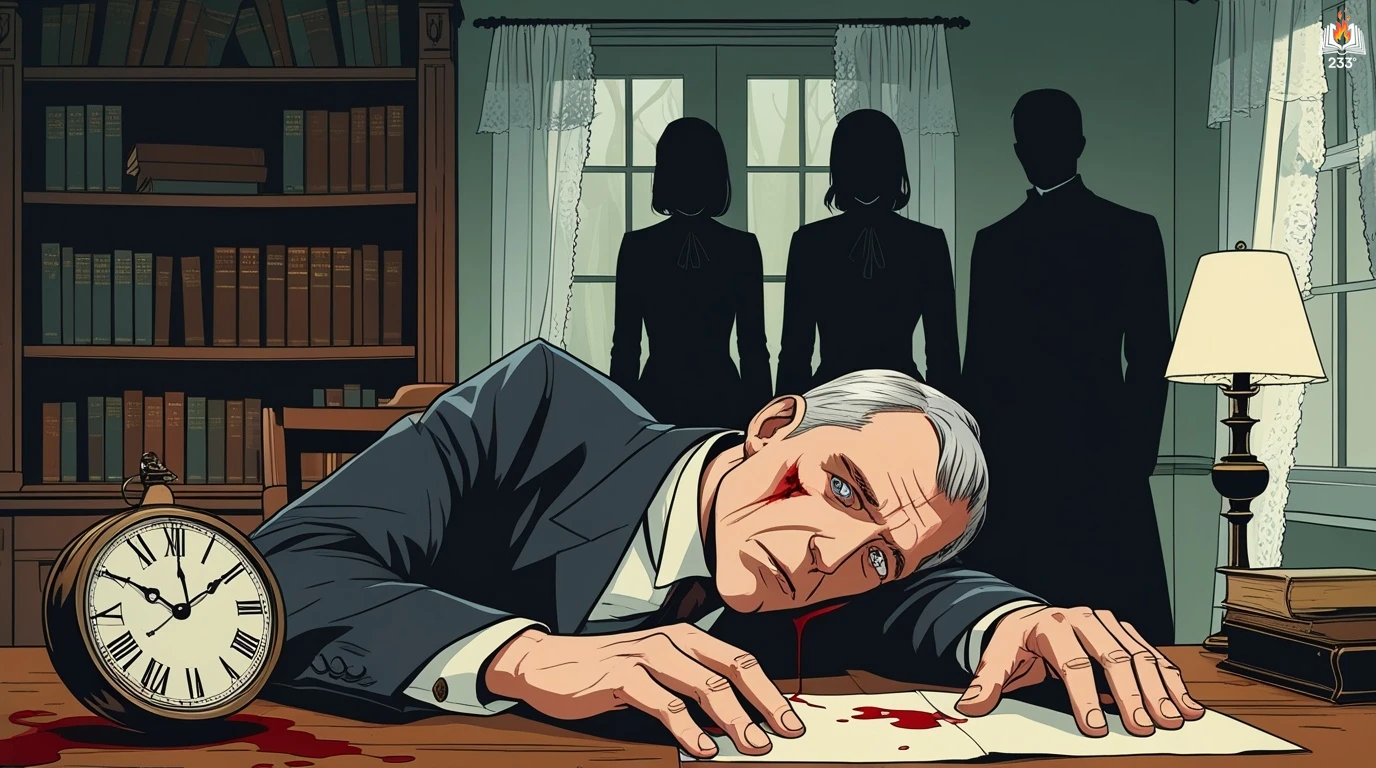Sleeping Murder, published posthumously in 1976, is one of Agatha Christie’s final Miss Marple mysteries and often considered her “final case.” Originally written during World War II and kept in a vault, it features Miss Marple helping a young couple unravel a long-buried murder. Christie’s mastery of suspense, psychological insight, and English village atmosphere shine in this chilling tale of memory, guilt, and buried secrets.
Plot Summary
Newly arrived from New Zealand, Gwenda Reed steps onto English soil with the excitement of beginning a new life with her husband, Giles. Eager to set down roots, she purchases a charming coastal home in Dillmouth called Hillside. But as Gwenda settles in, a strange sense of familiarity prickles at her. Without knowing why, she instinctively chooses the exact spot for a long-gone door and envisions wallpaper in the sitting room she has never seen. When workmen uncover evidence that matches her memories, unease begins to stir.
Troubled, Gwenda and Giles travel to London, where a night at the theatre sets the wheels of fate spinning. As an actress recites lines about murder, Gwenda faints, a sudden memory flashing across her mind – the image of a woman at the foot of the stairs, her throat twisted in agony. Concerned, Giles listens as Gwenda recounts her fragments of memory, and they turn to Miss Marple, the elderly yet sharp-eyed family friend, for guidance.
Back in Dillmouth, the young couple plunges into the past, determined to uncover the truth behind Gwenda’s lingering visions. Gwenda learns she spent her early childhood in Hillside before being sent to New Zealand after her father’s breakdown. The house becomes a vessel of memory, and soon, names from the past drift forward: Helen, Gwenda’s glamorous stepmother, who vanished without a trace; Kelvin Halliday, her tormented father; Dr Kennedy, Helen’s protective brother; and Walter Fane, Helen’s former fiancé.
Suspicion falls first on Kelvin Halliday, who had confessed to killing Helen during a jealous rage, yet no body was ever found. Dr Kennedy convinced authorities that Helen had run away with a lover, and Kelvin, wracked with guilt, crumbled into madness and died in a sanatorium. But as Miss Marple points out gently, things are rarely as simple as they seem.
Gwenda and Giles begin retracing the past. They visit the sanatorium where Kelvin lived his final years, uncovering his tormented writings filled with confusion and love for both Helen and his late first wife, Megan. They meet Edith Pagett, the loyal cook, and Lily, the gossipy maid, who recall Helen’s vivacious charm, her marital strains, and whispers of a mysterious man who may have lured her away. But who was this man, and why did Helen vanish so completely?
Miss Marple, always seemingly on the margins yet keenly observing, sifts through the delicate threads. She directs Gwenda to Walter Fane, the gentle solicitor once jilted by Helen. A quiet, restrained man, Walter hides his heartbreak behind a mild exterior, his pale eyes betraying the shadows of long-ago wounds. Yet he offers no answers, only a polite sadness.
As they probe deeper, Gwenda and Giles uncover the chilling possibility that Kelvin’s belief in his own guilt was carefully planted. Dr Kennedy, the respectable and composed figure, emerges as a more complex man. Beneath the veneer of brotherly concern lies a simmering possessiveness. Kennedy had loved Helen not as a brother should, but with a jealousy that poisoned his soul. Helen, in turn, had grown fearful, desperate to leave Dillmouth and start anew in Norfolk – a move she confided only to Edith Pagett.
The whispers of the past gather force. Lily recalls the night Helen vanished, the strange hush that fell over the house, the suitcase gone, the clothes carefully packed. Yet there had been no farewell, no sign of a lover, only an eerie absence. A foreign nurse, Leonie, glimpsed something from the nursery window – a shape, a struggle, a figure dragging another through the garden. Piece by piece, the fog begins to lift.
Miss Marple’s quiet wisdom sharpens into clarity. Helen had indeed planned to leave, but not with a lover. Instead, she was running from Kennedy’s suffocating grip. On the night she fled, Kennedy confronted her, his obsession spiraling into murder. Coldly calculating, he drugged Kelvin’s drink, strangled Helen in the hall, then arranged the scene in the bedroom. When Kelvin awoke, dazed and horrified, Kennedy fed him the story of his own guilt, ensuring his spiral into insanity. With Helen’s body gone – buried in the garden under Kennedy’s careful eye – the world accepted the tale of a wife who ran away, and Kennedy remained untouchable.
As Gwenda and Giles close in on the truth, danger stirs once more. Kennedy, sensing the threat, slips into their lives with a chilling blend of charm and menace. Yet he underestimates Gwenda’s resolve and Miss Marple’s sharp intuition. In a quietly tense confrontation, Miss Marple maneuvers the pieces into place, her gentle voice unearthing the killer’s buried guilt.
Cornered, Kennedy reveals his twisted love, his bitter jealousy, and the consuming need that led him to destroy the woman he could never possess. His confession, edged with both triumph and despair, seals his fate. The long-slumbering murder awakens at last, justice unfolding with the quiet inevitability Miss Marple always trusted would come.
As calm returns to Dillmouth, Gwenda and Giles stand at the threshold of their home, the shadows of the past lifting at last. The garden blooms once more, the walls no longer whisper of pain, and the house becomes theirs in truth as well as name. And in the distance, Miss Marple, knitting in hand, watches with a knowing, satisfied smile, having once again guided love and truth through the labyrinth of human folly.
Main Characters
Miss Jane Marple: An elderly spinster with a sharp mind and keen understanding of human nature, Miss Marple uses her wisdom and insight to untangle the dark secrets behind a decades-old murder. Though she seems unassuming, she’s the novel’s moral and investigative anchor, gently steering the younger characters toward the truth.
Gwenda Reed: A young woman newly arrived in England from New Zealand, Gwenda is determined, intuitive, and haunted by eerie memories from her childhood. As she and her husband settle into their new home, her reawakened childhood recollections drive the central investigation.
Giles Reed: Gwenda’s devoted and practical husband. Giles is skeptical yet supportive, providing a grounding presence as Gwenda becomes increasingly obsessed with solving the mystery of the past. His evolving trust in Gwenda’s instincts deepens their relationship.
Dr. James Kennedy: Helen Halliday’s brother, a respected and seemingly composed doctor. Beneath his surface charm lies complexity and possessiveness, and his role becomes increasingly pivotal as the truth about Helen’s disappearance emerges.
Helen Halliday: Gwenda’s beautiful, vivacious stepmother, whose murder lies at the heart of the mystery. Though absent in the present timeline, Helen’s personality and relationships are gradually revealed through memories, letters, and local gossip, painting her as both captivating and vulnerable.
Kelvin Halliday: Gwenda’s father, whose fragile mental state and tragic end haunt Gwenda’s investigation. His supposed guilt over Helen’s disappearance provides a red herring in the tangled plot.
Walter Fane: A quiet solicitor with a past connection to Helen. His mild demeanor and buried heartbreak hint at deeper emotional undercurrents and raise subtle questions about love, rejection, and repression.
Theme
Memory and the Unconscious: Memory shapes the entire narrative – Gwenda’s childhood recollections unlock the hidden crime. Christie explores how buried memories and the unconscious mind can both mislead and reveal, making memory a double-edged tool of truth and deception.
Guilt and Innocence: The novel weaves a psychological portrait of guilt, both real and imagined. Kelvin Halliday’s belief that he killed Helen contrasts with the actual murderer’s concealment, highlighting how guilt warps lives even when it’s misplaced.
The Haunting Power of the Past: Past events ripple destructively into the present, showing that unresolved crimes and emotions never truly die. The title itself, Sleeping Murder, reflects the idea that some wrongs, though buried, remain alive until confronted.
Appearances vs. Reality: Christie consistently plays with appearances, from Miss Marple’s harmless old-lady image masking a razor-sharp intellect to seemingly respectable characters concealing dark motivations. This theme fuels both suspense and social commentary.
Love and Obsession: Romantic entanglements drive much of the plot, contrasting healthy love (Gwenda and Giles) with toxic obsession (the murderer’s fixation on Helen). Christie portrays how love, when twisted into possession or jealousy, can destroy.
Writing Style and Tone
Agatha Christie’s writing style in Sleeping Murder is clear, economical, and subtly witty. She crafts dialogue that feels authentic and uses sharp, observant prose to paint vivid portraits of character and setting. Christie balances psychological insight with deft plot construction, creating a layered mystery where every detail counts. Her ability to sprinkle clues amid everyday conversation invites readers into an active engagement with the mystery, while her understated humor adds charm without diminishing the tension.
The tone of the novel is a masterful mix of cozy familiarity and chilling suspense. Christie lulls readers with the comforts of the English village – tea, gardens, and genteel manners – only to pull back the curtain on darker undercurrents of jealousy, betrayal, and violence. As the investigation progresses, the tone tightens, shifting toward eerie unease and culminating in a dramatic yet emotionally satisfying resolution. Miss Marple’s compassionate wisdom ensures the novel closes on a note of restored moral order, even as it acknowledges the pain left in the wake of tragedy.
We hope this summary has sparked your interest and would appreciate you following Celsius 233 on social media:
There’s a treasure trove of other fascinating book summaries waiting for you. Check out our collection of stories that inspire, thrill, and provoke thought, just like this one by checking out the Book Shelf or the Library
Remember, while our summaries capture the essence, they can never replace the full experience of reading the book. If this summary intrigued you, consider diving into the complete story – buy the book and immerse yourself in the author’s original work.
If you want to request a book summary, click here.
When Saurabh is not working/watching football/reading books/traveling, you can reach him via Twitter/X, LinkedIn, or Threads
Restart reading!








